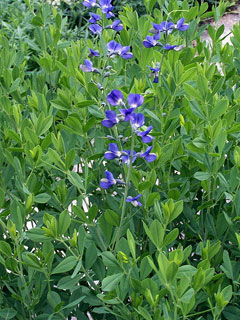 |
|
http://commons.wikimedia.org/wiki/User:Phyzome |
 |
| http://commons.wikimedia.org/wiki/User:Valérie75 |
Translate this page:
Summary
Bloom Color: Blue.
Main Bloom Time: Early summer, Late spring, Mid summer. Form: Upright or erect.
Physical Characteristics

 Baptisia australis is a PERENNIAL growing to 1.5 m (5ft) by 0.6 m (2ft in) at a slow rate.
Baptisia australis is a PERENNIAL growing to 1.5 m (5ft) by 0.6 m (2ft in) at a slow rate.
See above for USDA hardiness. It is hardy to UK zone 5. It is in leaf from May to October, in flower from July to August, and the seeds ripen from August to September. The species is hermaphrodite (has both male and female organs).
It can fix Nitrogen.
Suitable for: light (sandy) and medium (loamy) soils and prefers well-drained soil. Suitable pH: mildly acid and neutral soils. It cannot grow in the shade. It prefers dry or moist soil.
UK Hardiness Map
US Hardiness Map
Synonyms
B. exaltata.
Plant Habitats
Cultivated Beds;
Edible Uses
References More on Edible Uses
Medicinal Uses
Plants For A Future can not take any responsibility for any adverse effects from the use of plants. Always seek advice from a professional before using a plant medicinally.
Antiemetic Appetizer Digestive Emetic Purgative
Appetizer, digestive[61]. The root is antiemetic, emetic and purgative[222, 257]. There are confusing reports from two sources that the plant is used as an emetic and also that a cold tea is given to stop vomiting[222, 257]. A poultice of the root is anti-inflammatory and is held in the mouth to treat toothaches[222]. The plant is under investigation as a potential stimulant of the immune system[222].
References More on Medicinal Uses
The Bookshop: Edible Plant Books
Our Latest books on Perennial Plants For Food Forests and Permaculture Gardens in paperback or digital formats.

Edible Tropical Plants
Food Forest Plants for Hotter Conditions: 250+ Plants For Tropical Food Forests & Permaculture Gardens.
More

Edible Temperate Plants
Plants for Your Food Forest: 500 Plants for Temperate Food Forests & Permaculture Gardens.
More

More Books
PFAF have eight books available in paperback and digital formats. Browse the shop for more information.
Shop Now
Other Uses
A blue dye is obtained from the plant[257]. No more information is given, but it is likely to be the leaves that are used[K].
Special Uses
Food Forest Nitrogen Fixer
References More on Other Uses
Cultivation details
Landscape Uses:Border, Container, Foundation, Massing, Seashore. Prefers a deep, well-drained neutral to slightly acid soil in full sun[188, 200]. Grows freely in a loamy soil[1]. Succeeds in a hot dry position. Succeeds in a rich moist soil in sun or light shade[187]. Plants are hardy to about -20°c[187]. A very ornamental species, but it is somewhat shy flowering in British gardens[1]. Plants have a very deep root system and dislike root disturbance, they should be left alone once they are established[188, 233]. This species has a symbiotic relationship with certain soil bacteria, these bacteria form nodules on the roots and fix atmospheric nitrogen. Some of this nitrogen is utilized by the growing plant but some can also be used by other plants growing nearby[200]. Special Features:Attracts birds, Attractive foliage, North American native, Naturalizing, Attracts butterflies, Suitable for cut flowers, Suitable for dried flowers. The plant is heat tolerant in zones 9 through 1. (Plant Hardiness Zones show how well plants withstand cold winter temperatures.
Plant Heat Zones show when plants would start suffering from the heat.
The Plant Heat Zone map is based on the number of "heat days" experienced in a given area where the temperature climbs to over 86 degrees F (30°C).
At this temperature, many plants begin to suffer physiological damage. Heat Zones range from 1 (no heat days) to 12 (210 or more heat days).
For example Heat Zone. 11-1 indicates that the plant is heat tolerant in zones 11 through 1.) For polyculture design as well as the above-ground architecture (form - tree, shrub etc. and size shown above) information on the habit and root pattern is also useful and given here if available. The plant growth habit is a clumper with limited spread [1-2]. The root pattern is a tap root similar to a carrot going directly down [1-2].
References Carbon Farming Information and Carbon Sequestration Information
Temperature Converter
Type a value in the Celsius field to convert the value to Fahrenheit:
Fahrenheit:
The PFAF Bookshop
Plants For A Future have a number of books available in paperback and digital form. Book titles include Edible Plants, Edible Perennials, Edible Trees,Edible Shrubs, Woodland Gardening, and Temperate Food Forest Plants. Our new book is Food Forest Plants For Hotter Conditions (Tropical and Sub-Tropical).
Shop Now
Plant Propagation
Seed - best sown as soon as it is ripe in a cold frame[200]. Stored seed should be pre-soaked for 24 hours in warm water and then sown in a cold frame in late winter or early spring. Prick out the seedlings into individual pots as soon as they are large enough to handle and plant them out into their permanent positions in the summer or following spring. Division in spring[188]. Larger divisions can be planted straight into their permanent positions whilst smaller clumps are best potted up and kept in a cold frame until they are growing away well.
Other Names
If available other names are mentioned here
Native Range
NORTHERN AMERICA: United States, Connecticut, Indiana, Massachusetts, New Hampshire (southwest), New Jersey (north), New York (southeast), Ohio, Pennsylvania (southwest), Vermont, West Virginia, Illinois (northeast), Iowa (southwest), Kansas (east & central), Missouri, Nebraska (southeast), Oklahoma, Arkansas (northwest), Georgia (northwest), Kentucky (north), Maryland, North Carolina, Tennessee, Virginia, Texas (north),
Weed Potential
Right plant wrong place. We are currently updating this section.
Please note that a plant may be invasive in one area but may not in your area so it's worth checking.
Conservation Status
IUCN Red List of Threatened Plants Status :

Growth: S = slow M = medium F = fast. Soil: L = light (sandy) M = medium H = heavy (clay). pH: A = acid N = neutral B = basic (alkaline). Shade: F = full shade S = semi-shade N = no shade. Moisture: D = dry M = Moist We = wet Wa = water.
Now available:
Food Forest Plants for Mediterranean Conditions
350+ Perennial Plants For Mediterranean and Drier Food Forests and Permaculture Gardens.
[Paperback and eBook]
This is the third in Plants For A Future's series of plant guides for food forests tailored to
specific climate zones. Following volumes on temperate and tropical ecosystems, this book focuses
on species suited to Mediterranean conditions—regions with hot, dry summers and cool, wet winters,
often facing the added challenge of climate change.
Read More
Expert comment
Author
(L.)R.Br.
Botanical References
43200
Links / References
For a list of references used on this page please go here
Readers comment
© 2010, Plants For A Future. Plants For A Future is a charitable company limited by guarantee, registered in England and Wales. Charity No. 1057719, Company No. 3204567.